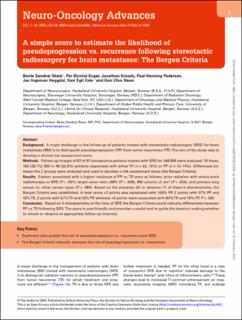| dc.contributor.author | Skeie, Bente Sandvei | |
| dc.contributor.author | Enger, Per Øyvind | |
| dc.contributor.author | Knisely, Jonathan | |
| dc.contributor.author | Pedersen, Paal-Henning | |
| dc.contributor.author | Heggdal, Jan Ingemann | |
| dc.contributor.author | Eide, Geir Egil | |
| dc.contributor.author | Skeie, Geir Olve | |
| dc.date.accessioned | 2021-06-30T09:12:30Z | |
| dc.date.available | 2021-06-30T09:12:30Z | |
| dc.date.created | 2021-01-13T10:50:14Z | |
| dc.date.issued | 2020 | |
| dc.Published | Neuro-Oncology Advances (NOA). 2020, 2 (1), . | |
| dc.identifier.issn | 2632-2498 | |
| dc.identifier.uri | https://hdl.handle.net/11250/2762508 | |
| dc.description.abstract | Background
A major challenge in the follow-up of patients treated with stereotactic radiosurgery (SRS) for brain metastases (BM) is to distinguish pseudoprogression (PP) from tumor recurrence (TR). The aim of the study was to develop a clinical risk assessment score.
Methods
Follow-up images of 87 of 97 consecutive patients treated with SRS for 348 BM were analyzed. Of these, 100 (28.7%) BM in 48 (53.9%) patients responded with either TR (n = 53, 15%) or PP (n = 47, 14%). Differences between the 2 groups were analyzed and used to develop a risk assessment score (the Bergen Criteria).
Results
Factors associated with a higher incidence of PP vs. TR were as follows: prior radiation with whole brain radiotherapy or SRS (P = .001), target cover ratio ≥98% (P = .048), BM volume ≤2 cm3 (P = .054), and primary lung cancer vs. other cancer types (P = .084). Based on the presence (0) or absence (1) of these 5 characteristics, the Bergen Criteria was established. A total score <2 points was associated with 100% PP, 2 points with 57% PP and 43% TR, 3 points with 57% TR and 43% PP, whereas >3 points were associated with 84% TR and 16% PP, P < .001.
Conclusion
Based on 5 characteristics at the time of SRS the Bergen Criteria could robustly differentiate between PP vs. TR following SRS. The score is user-friendly and provides a useful tool to guide the decision making whether to retreat or observe at appropriate follow-up intervals. | en_US |
| dc.language.iso | eng | en_US |
| dc.publisher | Oxford University Press | en_US |
| dc.rights | Navngivelse 4.0 Internasjonal | * |
| dc.rights.uri | http://creativecommons.org/licenses/by/4.0/deed.no | * |
| dc.title | A simple score to estimate the likelihood of pseudoprogression vs. recurrence following stereotactic radiosurgery for brain metastases: The Bergen Criteria | en_US |
| dc.type | Journal article | en_US |
| dc.type | Peer reviewed | en_US |
| dc.description.version | publishedVersion | en_US |
| dc.rights.holder | Copyright 2020 The Authors | en_US |
| dc.source.articlenumber | vdaa026 | en_US |
| cristin.ispublished | true | |
| cristin.fulltext | original | |
| cristin.qualitycode | 1 | |
| dc.identifier.doi | 10.1093/noajnl/vdaa026 | |
| dc.identifier.cristin | 1870426 | |
| dc.source.journal | Neuro-Oncology Advances (NOA) | en_US |
| dc.source.40 | 2 | |
| dc.source.14 | 1 | |
| dc.identifier.citation | Neuro-Oncology Advances (NOA). 2020, 2(1), vdaa026 | en_US |
| dc.source.volume | 2 | en_US |
| dc.source.issue | 1 | en_US |

